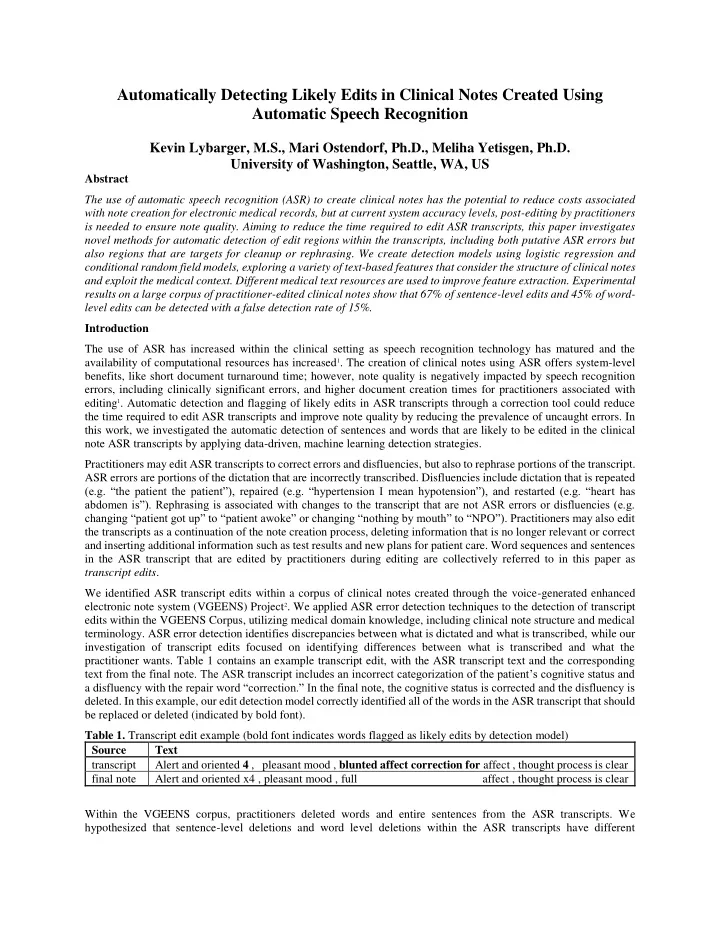

Automatically Detecting Likely Edits in Clinical Notes Created Using Automatic Speech Recognition Kevin Lybarger, M.S., Mari Ostendorf, Ph.D., Meliha Yetisgen, Ph.D. University of Washington, Seattle, WA, US Abstract The use of automatic speech recognition (ASR) to create clinical notes has the potential to reduce costs associated with note creation for electronic medical records, but at current system accuracy levels, post-editing by practitioners is needed to ensure note quality. Aiming to reduce the time required to edit ASR transcripts, this paper investigates novel methods for automatic detection of edit regions within the transcripts, including both putative ASR errors but also regions that are targets for cleanup or rephrasing. We create detection models using logistic regression and conditional random field models, exploring a variety of text-based features that consider the structure of clinical notes and exploit the medical context. Different medical text resources are used to improve feature extraction. Experimental results on a large corpus of practitioner-edited clinical notes show that 67% of sentence-level edits and 45% of word- level edits can be detected with a false detection rate of 15%. Introduction The use of ASR has increased within the clinical setting as speech recognition technology has matured and the availability of computational resources has increased 1 . The creation of clinical notes using ASR offers system-level benefits, like short document turnaround time; however, note quality is negatively impacted by speech recognition errors, including clinically significant errors, and higher document creation times for practitioners associated with editing 1 . Automatic detection and flagging of likely edits in ASR transcripts through a correction tool could reduce the time required to edit ASR transcripts and improve note quality by reducing the prevalence of uncaught errors. In this work, we investigated the automatic detection of sentences and words that are likely to be edited in the clinical note ASR transcripts by applying data-driven, machine learning detection strategies. Practitioners may edit ASR transcripts to correct errors and disfluencies, but also to rephrase portions of the transcript. ASR errors are portions of the dictation that are incorrectly transcribed. Disfluencies include dictation that is repeated (e.g. “the patient the patient”), repaired (e.g. “hypertension I mean hypotension”), and restarted (e.g. “hear t has abdomen is”). Rephrasing is associated with changes to the transcript that are not ASR errors or disfluencies (e.g. changing “patient got up” to “patient awoke” or changing “nothing by mouth” to “NPO”). Practitioners may also edit the transcripts as a continuation of the note creation process, deleting information that is no longer relevant or correct and inserting additional information such as test results and new plans for patient care. Word sequences and sentences in the ASR transcript that are edited by practitioners during editing are collectively referred to in this paper as transcript edits . We identified ASR transcript edits within a corpus of clinical notes created through the voice-generated enhanced electronic note system (VGEENS) Project 2 . We applied ASR error detection techniques to the detection of transcript edits within the VGEENS Corpus, utilizing medical domain knowledge, including clinical note structure and medical terminology. ASR error detection identifies discrepancies between what is dictated and what is transcribed, while our investigation of transcript edits focused on identifying differences between what is transcribed and what the practitioner wants. Table 1 contains an example transcript edit, with the ASR transcript text and the corresponding text from the final note. The ASR transcript includes an incorrect categorization of the patient’s cognitive status and a disfluency with the repair word “correction.” In the final note, the cognitive status is corrected and the disfluency is deleted. In this example, our edit detection model correctly identified all of the words in the ASR transcript that should be replaced or deleted (indicated by bold font). Table 1. Transcript edit example (bold font indicates words flagged as likely edits by detection model) Source Text transcript Alert and oriented 4 , pleasant mood , blunted affect correction for affect , thought process is clear final note Alert and oriented x4 , pleasant mood , full affect , thought process is clear Within the VGEENS corpus, practitioners deleted words and entire sentences from the ASR transcripts. We hypothesized that sentence-level deletions and word level deletions within the ASR transcripts have different
Recommend
More recommend